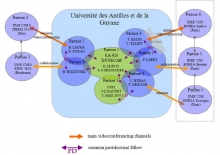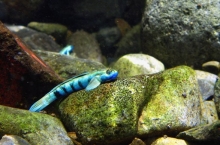CHLORINDIC Project : Effects of chlordecone (Kepone) contamination on epilithic biofilm in rivers: identification of elements of bioindication
ANR CESA Project : 2012-2016
Significant contamination by pesticides in some freshwater resources has been highlighted at the beginning of the 2000’s in Guadeloupe and Martinique Islands (French West Indies). Though they were banned from usage in the 1990’s, toxic and persistent molecules are still present in soils, with concentrations reaching 10 mg.kg-1 for the chlordecone (CLD) (Kepone®), the most worrying organochlorine (OC) residue, measured more than ten years after the last agricultural spreading. Driven by water cycle, this terrestrial pollution is progressively transferred into surrounding aquatic ecosystems, affecting both water and biota.
Chlordecone levels measured in Guadeloupe and Martinique rivers are among the highest values detected worldwide in freshwater ecosystems.
In a context where small-scale fisheries based on river crustaceans and fish contribute significantly to nutrition and sustainable livelihoods, so far, no organization or bioindicator was significantly found correlated with the contamination by chlordecone of the Caribbean freshwater ecosystems.
This work fits into the scope of emerging needs in research about chlordecone impacts identified in the second Environmental Health Plan (2010-2013) and, moreover, proposes to acquire elements for new bioindicators of freshwater pollution in tropical islands, based on epilithic biofilm.
Collaborators: Team 6 UMR 7208 BOREA, UMR IPREM 5254 (Pau), UMR CNRS 5805 EPOC (Bordeaux), GTSI (Pointe à Pitre)
Contact BOREA : Dominique Monti, Team 4, dominique.monti@univ-ag.fr



